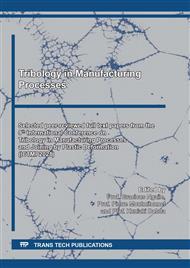p.3
p.13
p.21
p.33
p.39
p.45
p.51
p.59
p.69
Test of a New Water-Based Lubricant in Turning of 316L Stainless Steel
Abstract:
In recent years, hybrid manufacturing combining additive and subtractive processes is gaining increasingly importance in the industry. One of the issues related to this association of processes concerns the use of cutting fluids, important to optimize the machining part, but that can strongly affect the additive part by generating pores in the laser metal deposition. The present work deals with the performance of a new ecological cutting fluid that dries just as water, eliminating the need for a cleaning step between the machining and the laser metal deposition. This lubricant is an emulsion mainly composed of water and alkylphosphonic acids known to allow creating a low-friction tribofilm on metals. This study is carried out by comparing the machining performance of this new cutting fluid with two more classical lubricants, a straight oil and a soluble oil. It was found that machining forces and surface roughness were not very affected by the change of the lubrication mode, while the tool wear showed a significant difference between the dry and the lubricated cases. Considering that the performance of all the cutting fluids was very close, it was concluded that the new lubricant has a great potential for machining applications, since it is ecologically more friendly, non-harmful to the operator and does not need a degreasing step.
Info:
Periodical:
Pages:
39-44
Citation:
Online since:
February 2022
Price:
Сopyright:
© 2022 Trans Tech Publications Ltd. All Rights Reserved
Share:
Citation:


